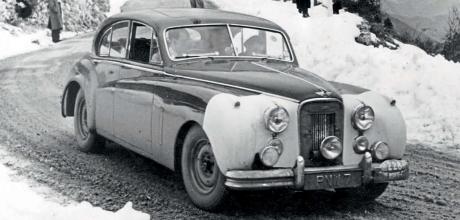Jaguar MkVII finishes second on 1953 Monte Carlo Rally
Despite Ian Appleyard dominating the Alpine Rally throughout the early Fifties with his cream XK120, registration NUB120, since the Monte Carlo Rally’s rules at the time demanded cars over 1ó litres had to be four-seaters, it meant he had to ditch the sports car in favour of a MkVII instead. For his first Monte in 1952, Appleyard ordered a brand new example, registered PWN 7, but due to poor weather he, together with his co-driver wife, Pat (who was also the daughter of chairman of Sir William Lyons) finished a lowly 53rd. He would use the car again for that year’s Tulip Rally in April when he came home a strong second.
Finishing lines
With Appleyard becoming more involved with his family’s Leeds-based motor business, he came close to not entering the 1953 Monte Carlo Rally. But it seems by November the previous year he’d had a change of heart when he wrote to Jaguar’s new competitions manager, Mortimer Morris-Goodall, asking for PNW 7 to be prepared for the French event. “The car is at present non-standard in a number of ways,” he explained, “as the Tulip Rally regulations permit anything.”
He sent another letter a month later, this time to Jaguar’s engineering director, Bill Heynes, recommending a reconnaissance for the rally. This resulted in a full ‘factory service’ for the 19 Jaguar entrants which included co-operation from the company’s official agents both in the UK and abroad plus the availability of a works car for a practice run around the Col de Braus mountain circuit during the first week of January.
As with the other 102 British competitors, Ian and Pat left for Monte Carlo from Glasgow before heading directly to Dover and a ferry that would take them across the Channel and onto the continent. But due to France enjoying unseasonably mild weather the snow and ice that usually hampered the entrants wasn’t a problem and of the 404 starters, 253 reached Monaco unpenalised which included the Appleyards. Stirling Moss, who was driving a Sunbeam-Talbot, described the conditions as, “too easy”. And so the braking and acceleration tests were the only means of selecting the top hundred that would progress through to regularity test around the Col de Braus. Due to Ian’s precise driving, the Appleyards finished second behind Sydney Allard in his P1.
To prevent the competitors from taking the timekeepers by surprise and passing the checkpoints without being spotted, the organisers decided to paint the front wings with white washable paint as seen in this image of Appleyard’s MkVII.
The average speed around the 50-mile circuit was set at 29mph yet despite the snowy weather on top of the Alps, Appleyard finished second overall behind the Ford Zephyr of Dutch driver, Maurice Gatsonides. With Cecil Ward finishing fifth in his outclassed MkV plus other MkVIIs coming home in eighth, 15th and 22nd places, it was a tremendous result for Jaguar. It was also Appleyard’s final podium finish in his MkVII. Following ever more sporadic appearances over the next three years with a new XK140 (RUB 140), he retired from competition for good in 1956.


